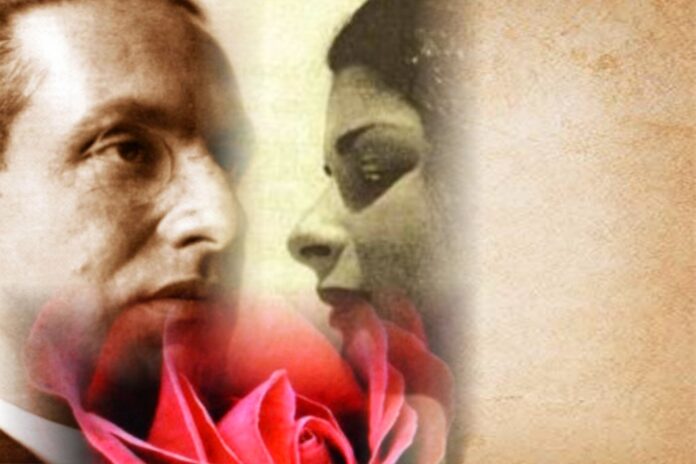Julius Evola and Maria de Naglowska
1.
After writing the book Metaphysics of Sex in 1958, Julius Evola sometimes thinks back to his past existence, above all to the one related to the magical practices of sexuality. These practices now live in the symbolic figures of his own thought. The images emerging at that moment of his existence are the inspirations for his text. They are embodied by the women that he met, but also by unknown ones and sometimes by those who have transfigured in the body of its alchemical symbols. Their eyes continue to vibrate to meet his reflective gaze.
2.
(…) On a summer night, from the open window of his room, he hears the voices of some men talking to a woman in the distance. Suddenly, the voices transmute into the sounds of a ballad. Julius senses that the woman has become the unique protagonist of that collective male desire. He perceives the wild charge which ignites that attraction. The same happens in his Ballad in red, written forty years earlier, of which he repeats, in a soft voice, some verses: blades of cruelty and extreme voluptuousness in my ballad in red for you / tonight.
(…) Listening to the conversation between the men and that woman, the object of their attraction, Julius imagines an erotic ceremony, held in a sadomasochistic setting, which is transformed into a ritual of knowledge. This can still be expressed through the words of his Ballad in red: Because now you are in my power … / They took you to the small closed room in front of my seated indifference …. / tear down to the seal to the secret of your being closed darkness between your thighs.
“Julius, Julius, look at me …” echoes a female voice on a winter night, during another of his visions, while watching the women who had embodied the path of his alchemical eros.
That female voice, full of magical presence, wants to enter his images conversation. It belongs to the Russian Maria de Naglowska whom he met in Rome in the early 1920s. This relationship of art and thought brings him back to the origin of his expressive journey, when he met Maria in her early twenties, older than he was. With her, he translated the poem The dark word of the interior landscape from Italian into French, which he interpreted at the Grotte dell’Augusteo in Rome, in the autumn of 1921 during a Dada event. The original manuscript of the poem, by their will, had to be hidden in a cenacle of esoteric lovers.
Maria de Naglowska was interested in the female potential of magic sexualis. As a poet and person involved in occult-esoteric practices, she had the right sensitivity to enter that poetic search for assonances and sensory references. She cooperated with him to the creation of a language through which the internal orgasm expresses the vibrational sounds of poetry. Maria identified herself with M.lle Lilan, one of the four female dialoguing voices in the poem.
Julius Evola sees himself again, in a subsequent series of images, in a white room with a white bed, where the red of the cushions and the blanket emerge creating an alchemical visual ignition. Here he is hugging Maria, after looking at each other, for a long time, without any physical contact. She is naked. The gaze and nudity, in their relationship, become a way to amplify and make their own desire transcend towards a magical eros.Their dialogue is expressed through the sound of the word. This embodies the inner orgasm of the dark word that both had sought in the translation of the poem.
I was inspired by the unpublished text of Evola “The Secret Picture” (1970) which will be published in an anthology on the fictional life of Julius Evola, edited by Gianfranco de Turris.








